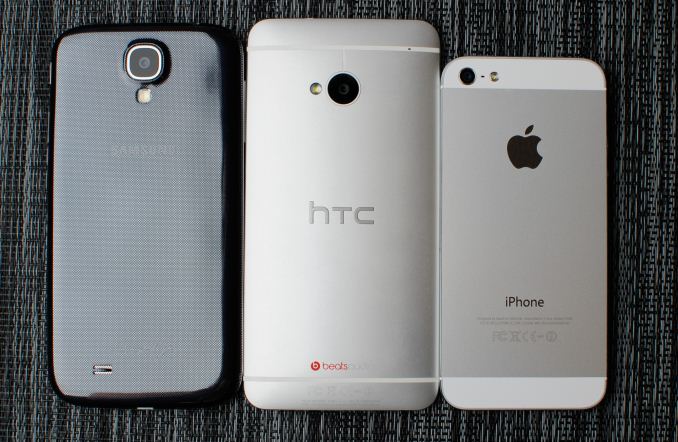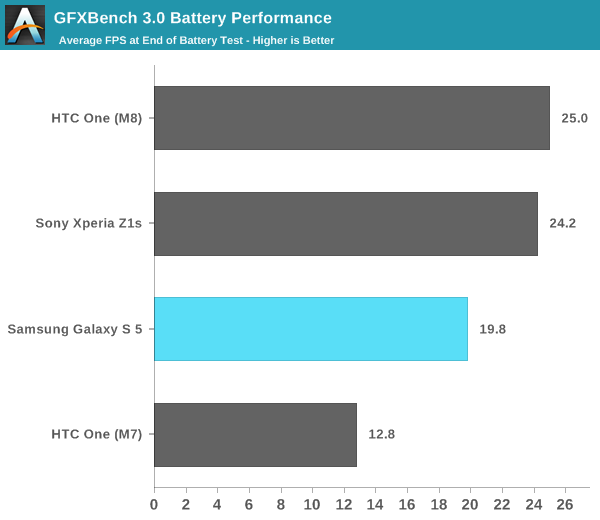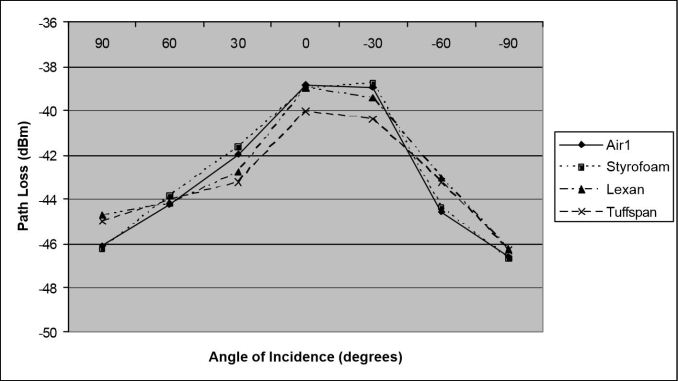A Discussion on Material Choices in Mobile
by Joshua Ho on May 5, 2014 8:00 AM EST- Posted in
- Smartphones
- Mobile
- Tablets

Within the past four years, the smartphone market has changed drastically. Displays have dramatically increased in quality. Battery life has increased. As OEMs converge on largely similar platforms, the material design of a phone has become increasingly important. Almost every OEM has had a major shift in the material design of their devices as the market becomes increasingly saturated and competitive. This is especially true at the high end where the upgrade cycle has become lengthened. As people find less and less reason to upgrade to the latest and greatest, OEMs have to change things to stave off decreasing growth. Overall, this seems to mean going "back to basics" with their new devices, which often entails improved material design.
This seems to make very little sense, especially when there are a great deal of people that simply aren’t concerned with materials. It's not unusual to hear the argument that because everyone uses a case, the design of the device shouldn’t matter. It's often said that aluminum devices are less durable, heavier, and with worse radio reception than one made of polycarbonate. Other issues often cited include uncomfortable skin temperatures under load. Higher cost is also a problem, one that OEMs will often cite internally. With glass, it's almost universally understood that any drop risks shattering the brittle back. So the question remains: Why is it that OEMs continue to push material design?
Without a doubt, this is a complex topic. Material choices entail a huge number of trade-offs. There isn't any one material that has the best compromises either. For the most part, there are three key materials that smartphones are made from. These three materials are plastic, glass, and metal.
Plastic
Within plastics, the most commonly used material is polycarbonate, which has high impact resistance, relatively good temperature resistance, and it’s also extremely flexible. A great example of polycarbonate would be the battery door of the Galaxy S and Note line, or Nokia's Lumia devices. In general, it’s almost impossible to point to a phone with a polycarbonate external build that has reception issues, as polycarbonate effectively doesn’t attenuate radio signals, as shown on page 38 of this study of radio propagation differences. As the market becomes squeezed by decreasing profit margins, the low price of polycarbonate relative to glass or metal is also a significant advantage that can't be overlooked.
While these are advantages are reason enough to make a smartphone or tablet with a polycarbonate casing, there are disadvantages as well. Polycarbonate is a poor conductor of heat, which means that with today’s thermally constrained devices, true nominal clockspeed for both CPU and GPU on the SoC will be lower than a phone or tablet that is made of metal such as aluminum and magnesium. The same is also true when comparing a device made with polycarbonate and one with glass in general. For reference, the thermal conductivity of aluminum is 205 watts per meter kelvin, 156 W/m*K for magnesium, .8 W/m*K for ordinary glass, and .22 W/m*K for polycarbonate. The unit refers to the rate of energy transfer needed to heat up a length of material by a certain unit of temperature. This means that in today's phones and tablets, one made from plastic will generally run slower in intensive games than one made of metal or glass, if all else is equal.
On top of this, while polycarbonate is extremely impact resistant, the flexibility of the material is a major issue for smartphones that have to be as thin and compact as possible. People often bring up the car analogy to argue that polycarbonate protects a phone or tablet better, but there's no such thing as a crumple zone in a phone. Even the back cover serves a purpose, as antennas are inserted into the back cover in order to have the space for the huge number of frequencies supported. Bending the back cover into the phone is often a dangerous problem, as it will affect the delicate antenna connectors, which are often small, spring-like pieces that make contact with the back cover. This is an issue, as while the metal antenna connectors are elastic to a certain extent, once stretched too far it won’t spring back. One of the most notable examples of this issue can be seen with the Tegra 3 variant of the HTC One X. This variant of the One X would often lose all WiFi and Bluetooth reception due to crushed antenna connectors. Fixing the problem required additional reinforcement to prevent the back cover from bending in too far. As seen in the photo from iFixit's teardown of the Galaxy S4 below, the connectors are small gold-plated nubs that touch parts of the back cover.
Metal
On the other end, metal is often hailed by reviewers as a superior material. However, most reviewers focus upon look and feel, rather than the technical advantages and disadvantages of using metal. Of course, metal is an extremely broad term and comprises around 80% of the known elements in existence. For this discussion, the key metal used for the outer casing is aluminum. Magnesium is another commonly-used material, but is mostly limited to the midframe.
Of course, aluminum alloys have their advantages as well. With the stiff alloys used in smartphones and tablets, there is a significant structural advantage that helps to protect internal components. To go back to the car analogy, because there aren't crumple zones in a compact phone or tablet, there is only the safety cell. The safety cell is made to be as rigid as possible to prevent crushing the contents within the safety cell. In short, aluminum is actually more durable, not less. As pointed out back in the iPhone 4 review, the external antennas required by all-aluminum designs can give better reception and performance than internal antennas. Even today, it's possible to see better reception performance from an all-metal device. For example, the Sprint One M8 has a higher effective isotropically radiated power (EIRP) on 1900 MHz CDMA than the Sprint Galaxy S5. Higher EIRP generally translates into better radio reception, although it also takes effective isotropic sensitivity (EIS) to see the full picture.
Because of metal’s higher stiffness, it’s also harder to scratch the surface. However, with anodization treatment, scratches are more likely be visible if they expose the untreated surface. Another key advantage is the much higher thermal conductivity of aluminum, which allows for better performance in situations where a device is thermally limited. After all, heat sinks are made of aluminum and/or copper, not polycarbonate or glass. The best example of this can be seen in the comparison between the Galaxy S5 and HTC One (M8) in the T-Rex rundown test, as the frame rate of the One (M8) is significantly higher than the Galaxy S5’s, as seen in the graph below.

Like every other material, Aluminum is also not the perfect material to make a mobile device. As a result of making the device from metal, it’s impossible to use internal antennas unless plastic/glass “windows” are used to allow signal in and out of the phone. This means that the device will be less isotropic (direction-independent) in its reception of radio signals. Even with external antennas that turn parts of the metal casing into an antenna, detuning that occurs when a hand touches the antenna or bridges it to another conductive body is a major problem, as is the need to support multiple frequencies with an external body that isn’t necessarily able to change, as the iPhone 5s/HTC One (M8) can't look radically different from operator to operator. While the use of multiple antennas (receive/transmit diversity) and active antenna tuners have made all-metal designs possible, there is still a noticeable difference in radio reception. Whether this difference is for better or worse depends upon the frequency used.

Outside of radio reception, aluminum alloys’ lower limit of elastic deformation means that while the casing is better at protecting internal components, it's more likely to receive cosmetic damage. On the other hand, polycarbonate is more likely to come out of a drop without dents or gouges. Aluminum bodies are also significantly more expensive, as the time and cost associated with working the material into a final product means that the difference in price can be as great as an order of magnitude. This can take away from other aspects of the device. Finally, while aluminum is far more effective at dissipating heat than polycarbonate, this also means that the polycarbonate device will have lower perceived skin temperatures under load. What that means is that it’s more comfortable to hold a polycarbonate-bodied device even if the internals are at higher temperatures. This also means that low temperatures will cause an aluminum-bodied device to feel much colder than a polycarbonate-bodied one.
Of course, magnesium changes things up as well. It's lighter than aluminum due to its lower density, more RF transmissive than aluminum, and in general, carries many of the advantages that aluminum does over plastics such as polycarbonate and aluminosilicate glass, which include high thermal conductivity, relatively high rigidity, and relatively better scratch resistance. In theory then, magnesium would be better than aluminum.
Unfortunately, from a mass production standpoint magnesium casings are generally infeasible, although still possible. This is primarily due to the reactive nature of magnesium in oxygenated environments, and due to outgassing that occurs during the baking process. Without surface treatment, magnesium rapidly corrodes as well. This means that it's not currently feasible to use magnesium as an external casing, although many manufacturers use it for the midframe.
Glass
Not to be forgotten, glass is another possibility for the external casing of a tablet or smartphone. It is the most rigid of all three materials and resists scratches the best. However, it is also the most brittle and susceptible to shattering. This is because glass can only deform elastically. Aluminosilicate glass, more commonly referred to as Gorilla Glass (when made by Corning) is the most common type of glass used for the external casing of a phone. It is between aluminum and polycarbonate when it comes to thermal conductivity. However, it is only slightly more conductive than polycarbonate, and far less conductive than aluminum. It also doesn’t significantly attenuate radio signals, which means that internal antennas can be used. Of course, the disadvantage is that glass is incredibly fragile, and can pose a major safety hazard. The shape of the phone is also significantly constrained. This is why glass-bodied devices have generally been small and the glass portion of the device is generally a flat sheet.

As mentioned previously, there are plenty of complications as well once you factor in the actual layout of the device. Thermal dissipation of a polycarbonate-bodied device can be improved by using a magnesium midframe that dissipates heat into the display and other components. This increases the rate of heat transfer from internal components to the air/hand. Wall thicknesses and different types of plastic, metal, and glass can significantly decrease the severity of issues associated with the disadvantages of various materials. For example, adding ABS plastic to polycarbonate can significantly increase the rigidity of the material. Applying anti-shatter film to glass can catch shards in case the glass shatters to reduce the hazard involved in shattered glass. New antenna tuning technologies can enable all-metal devices.
Conclusion
Of course, the question still remains. Why is it that all of this matters? After all, Apple didn't have to worry about thermal dissipation with the iPhone 4 because the SoC didn't generate enough heat, but they used a steel side ring and glass back cover. While the glass back cover and stainless steel ring was more effective at protecting the internal components, minor improvements to drop protection and possible improvements to reception wouldn't be strong justifications for pursuing such a design. So why would Apple do this?
The answer lies in industrial design. While it's all too easy to conflate this with pure aesthetics, industrial design is a crucial aspect of any device. After all, smartphones and tablets are both touched all the time, and while we look at the display primarily, the shape, look, and feel all dramatically affect the experience. If it fits the hand better, feels better, and looks better, it is better. Unnecessary elements hurt the focus of the design, honest design helps it. Good design is obvious and invisible. It's only when we use something poorly designed that we see what is well-designed. Advances in technology can and do fix the issues that materials have, but nothing can fix bad design. While most of these are subjective, as the mobile industry reaches saturation, both industrial design and material design will become crucial differentiators. If anything, it already has.












77 Comments
View All Comments
Stochastic - Monday, May 5, 2014 - link
You have to put that in context. Battery life has remained largely stagnant not because we haven't seen improvements in battery chemistries and component efficiency but because user workloads have intensified.Impulses - Monday, May 5, 2014 - link
The improvements haven't kept up with the workload tho and it wasn't until very recently that battery capacity became a big deal and more OEMs started using 3000mAh or better. Moto sold several generations of Maxx models before anyone followed suit, kinda silly.I blame Samsung, the race to the thinnest phone possible was as dumb as the megapixel wars with P&S. Getting to 10mm or so was nice from an ergonomic point of view, but heck, I'd gladly take a 12mm thick phone with a 4,500+ mAh battery.
hrrmph - Monday, May 5, 2014 - link
The article was great as far as it went with a scientific comparison of the different materials.Then the article fell apart and went into "la la" fantasy land with yet another emotional justification for the superiority of the iPhone's industrial design. There was a slight twist in that the argument wasn't good looks, but in-hand feel. Uhh... like we haven't heard that before already.
And like we haven't rejected that silly argument before. Functionality is how I (and most people in the world) buy smartphones, phablets, and tablets with our hard earned money.
Case in point: My hapless colleague just arrived back to work from a wonderful bucket list vacation. He took photos of this tropical vacation and photos of his newly built house. He is living large (and the bankers love him for it). So obviously he wanted to show me pictures, right? But he couldn't.
Why? Because he is stuck with a low capacity iPhone that has no possibility of expanding the storage and his phone quickly filled up with other stuff withing 6 months or so of his buying it and now he is out of capacity, and thus capability to use his device as he would really like to.
So why don't you ask him how he thinks about the in-hand feel trade-off now?
Meanwhile, back at 'Sanity Base', my Blackberry Z10 has a 64GB Micro-SD and holds an awesomely large collection of high quality lossless encoded music that I enjoy every day, along with a 100,000 page collection of government published regulations, advisories, handbooks, and technical data (not to mention being a great business communication device).
My nearby Note 2 phablet has a 128GB Micro-SD and has all of my Full-HD vacation videos as well as a complete copy of my photo collection that covers 4 generations of my family, friends, and colleagues. Oh... it also has a copy of that same massive collection of awesome lossless and high-definition music... just in case.
So save the faux-science arguments that industrial design is the deciding factor in these things. It's not. It never has been. Except perhaps for folks who are hung up on devices as social status elevating 'jewelry' pieces.
Apple's real strengths are its software design. And even then it comes with the caveat that you are more or less forced to buy into a cripplingly closed ecosystem where Apple plays a god-like role of telling you what you can and cannot have or do with your device.
Then again, Apple (just like Microsoft) has abandoned some of their best software design elements and thrown them out. Why? Just to try to look trendy and new. In both cases, it reeks of desperation to keep churning cash flow, as opposed to offering something better. Sometimes there isn't anything better to be designed into a certain software applet because the existing functionality has already reached the zenith of design for that product class.
Then you add in Apple's utter lack of options for removing the back cover and battery easily. Combined with the inability to expand the storage, its a death knell for a savvy user's interest in buying the device. Even if the industrial design provides a good in-hand feel, it still remains a paperweight... well... almost as useless as a paperweight... albeit one that feels good in-hand.
For what it's worth, the plastic BB Z10 feels great in hand. It's cheap, high quality, and I appreciate it's low social status and lack of blinginess. My Note 2 has a nice pleather case, so I can't say that I even know what it actually feels like anymore. But, functionality on both devices is great.
The next device that I will buy will be a 7" or 8" class phablet to replace my half crippled (by design) Nexus 7. You can be absolutely sure that industrial design (that is the jewelry aspect of the device) will be on my spec list...
... like down around number 25 or so in importance.
Functionality has, and always will rule most of this global market. Will there be pockets of irrational behavior? Yes. Where will you find them? Where you find idle cash, high emotions, and plenty of zealous marketers (and media like AnandTech) who are willing to stir that irrationality.
Stochastic - Monday, May 5, 2014 - link
I don't think Joshua was commenting on the overall value/worth of the iPhone. Rather, he was pointing out that one of the advantages of a metal design is that for many it improves subjective in hand feel. Whether this advantage overcomes other disadvantages of the iPhone (e.g. lack of user replaceable battery, lack of storage expandability) is up to each user to decide based on their own personal criteria.JoshHo - Monday, May 5, 2014 - link
To add to this, it doesn't take a metal design to have good ID. Ultimately, the key point is that all OEMs seem to be converging on similar designs, so ID/MD is now a key area of competition.JoshHo - Monday, May 5, 2014 - link
I'd just like to mention that only time I've ever daily-driven an iOS device was around a week back in 2011. I do have plenty of experience with recent iOS devices though.Impulses - Monday, May 5, 2014 - link
You know, it doesn't take a removable media card to have expandable storage, not with USB OTG on every Android handset and tablet out there at this point. It's fairly trivial to hook up a USB drive to a phone these days, there's even about half a dozen USB drives and readers on Amazon that have dual plugs (USB for PC and micro USB for OTG use). This idea that no removable storage = crippled device is pretty tired.You know what really does kill storage tho? (and what very well may have sapped your friend's IPhone storage) The fact that iOS is terrible at managing it and iMessage is a horrible mess after long term use. Every photo you send thru iMessage gets permanently duplicated within iOS devices and even across backups (so it clutters iCloud as well), what's worse, there's no easy way to delete them. For some reason when you delete a message thread in iMessage it never gets deleted, just hidden, it's still in storage and often it's revealed to the user again after a reboot.
It's truly bizarre behavior, there's literally no intuitive or built in way to delete all that crap, you have to resort to 3rd party tools that allow you to edit iOS backups which you then have to restore (of course you need space for that so first you have to wipe the device). Ran into this issue recently with a client who had three years (backups restored across devices) and 11GB worth of iMessage data cluttering her phone, she complained when she couldn't take photos.
If I were a cynic I'd say it's a ploy to get people to buy higher capacity devices, but it just seems like a massively short sighted decision on the part of developers who didn't expect people to carry over iMessage data across a single (or multiple) device for 2-3 years at a time.
Impulses - Monday, May 5, 2014 - link
Plus storage just isn't an issue for a ton of people out there, most of my family members have 2-5GB in use avoid l across their phones and it's all photos that get automatically backed up to an account when on Wi-Fi. They have no idea why anyone ever pays more for 32&64GB devices...bradleyg5 - Tuesday, May 6, 2014 - link
"This means that in today's phones and tablets, one made from plastic will generally run slower in intensive games than one made of metal or glass, if all else is equal."I would like to see you actually test this, take an hour long game session of XCom or other game that runs the GPU at max clock rate. Measure with trepen profiler to see which mantains a higher average clock rate. Very easy to test.
Test I did with my Note3 to show the impact of fan cooling a phone, I'd love to be able to test this with other devices. http://imgur.com/a/l3SJ8
JoshHo - Tuesday, May 6, 2014 - link
I saw your post on /r/Android, we use GFXBench to simulate the intensive workload to measure throttling.